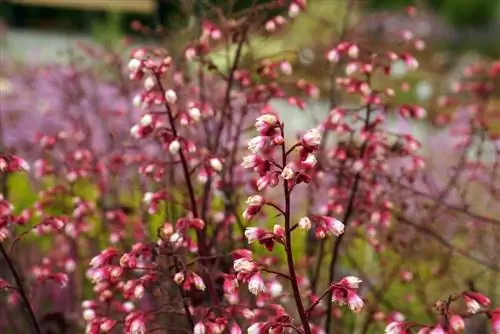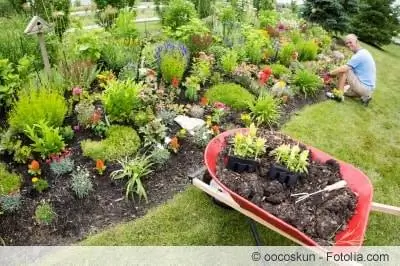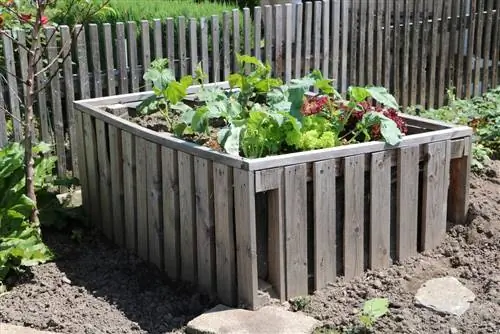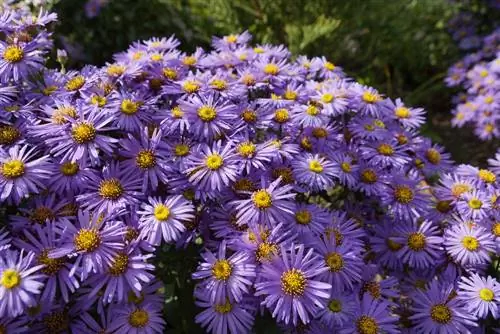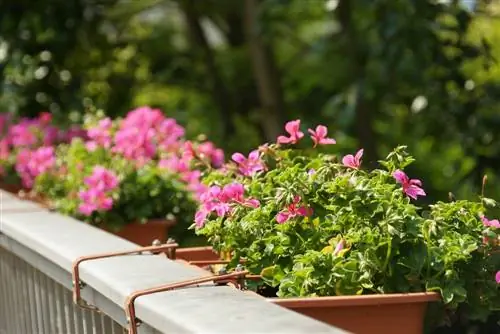- Author admin [email protected].
- Public 2023-12-17 03:39.
- Last modified 2025-06-01 06:48.
Flower boxes are a very popular decoration on every balcony as well as on terraces and window sills. They seem friendly and bring a lot of color into stressful and sometimes colorless lives. They also give dull house walls and boring balcony railings a very special touch. The design of the boxes can be quite different. This makes it possible to set very specific accents with targeted planting. Depending on the plants, you can also decide how colorful and varied a flower box should be and how much care should be required. Depending on the plant selection, this can also be influenced individually.
Note the season
If a flower box is to be planted all year round, then you have to work with different plants, grasses and decorative items. As a rule, it is pansies and other early bloomers that open the season in March or April. Once these have faded, the summer bloomers are used, but they will have faded by October at the latest. Then the time of year has usually come that leaves little scope for planting. Either you rely on evergreen trees over the winter months or use heather, which is also green in winter. Or you can decorate the boxes with artificial decorations, which are not always desired. - But it doesn’t necessarily have to be that unimaginative. So here are a few tips to keep flower boxes looking beautiful all year round:
Flowers for spring
As we all know, the gardening season begins after the frosty days. This also applies to flower boxes, which can be freshly planted again for the first time after the cold winter in March or April. But before this happens, the flower boxes should be well prepared for the new season. So it's worth filling in fresh soil after the winter. Whether this is special soil for flower boxes or conventional garden soil depends on the planting. You should also consider what the planting should look like throughout the year. With planning for the entire year, you can always keep the boxes looking beautiful.
Plants with a short flowering period that can be purchased as finished plants are suitable for spring. In addition to the ever-popular pansies, these include primroses, heathers and grasses.
If you want to prepare for spring in the fall, you can put onions in the flower boxes. This is particularly popular with tulips, daffodils, daffodils and hyacinths. The onion plants can also be combined with the plants that have already been planted in spring. This creates a great mix and the flower boxes can shine in a great mix of colors from the first frost-free days.
Flowers for summer
In summer it is advisable to go for flowers with a long flowering period. Since temperatures are higher in summer and sunlight must also be taken into account, a distinction is made between different plants for the flower box. So there is:
- Plants for a sunny location
- Plants for a partially shaded location
- Plants for a shady location
- Plants for every location
The plants for a sunny location that are particularly suitable for flower boxes include the blue fan flower, clematis, chrysanthemums, fat hen, geraniums, daisies, lavender, midday gold, petunias or also mallow or vanilla flowers. In a partially shaded location, begonias, boxwood, dahlias, monkshood, angel's trumpet, fuchsias, bluebells, petunias and many other flowers can grow excellently in flower boxes. Begonias, ivy, primroses, bluebells and fuchsias are suitable for shady places.
Tip:
Some of the plants mentioned can thrive in all locations and are therefore the absolute favorites among balcony plants.
Planting for autumn and winter
Once the summer flowers have faded, it's time to prepare and stock the boxes for autumn and winter. Not always an easy task, as the cold season offers little opportunity for colorful planting. Many people rely on fir branches that are simply stuck into the ground and enhanced with a little decoration. Others use heather, which survives the winter well and therefore provides at least a small splash of color. However, if you want something more varied, then we recommend fruit-bearing plants, such as snowberries, mahonia branches or even cotoneaster or privet.
The permanent planting
Some people also like to add permanent plants to their flower boxes. Slow-growing small trees should be used. Zerg conifers can also look very beautiful and decorate the flower box all year round. Small decorative materials can be added depending on the season and provide a little variety. However, care should be taken to ensure that the wind cannot tear anything out of the flower box and that people may be injured as a result. This is particularly important if the flower box is attached to a balcony where people can be.
The flower box must also be large enough for permanent planting. Small trees and conifers have a much greater root formation than flowers and perennials. They therefore require more space than with seasonal planting. In addition, hanging plants such as ivy, which is also suitable as a permanent plant, must not grow too long and must be trimmed and cared for regularly.
Frequently asked questions
Which plants are most suitable for a flower box?
There are no clear rules because you should plant whatever you like. However, the location must be taken into account and the box should not be too overloaded so that the flowers have enough light and space.
Are there plants that can stay in the flower box permanently?
Small trees, ivy, herbs or even heather are ideal for permanent planting.
Are there any regulations when attaching a flower box to the balcony?
Yes. And usually very precise ones, which can vary greatly depending on the owner and the area in which they live. Everyone should therefore take a look at the rental agreement before installing a flower box on the balcony.
What you need to know about planting balcony boxes
- No more than seven to eleven plants should be placed in an approximately 1 meter long balcony box.
- It's best to plant them slightly staggered and not all in a row. This way they can spread better.
- Put the hanging plants at the front and the standing ones a little back. You can plant the flatter flowers in the middle.
- So that the plants get enough air, you should ensure there is sufficient planting distance.
- When selecting plants, you should also consider that the water requirements of the flowers in a box should be approximately the same.
- Thirsty petunias, for example, should not be planted together with fairy spur.
- You should generally use new soil so that plenty of air gets to the roots. Last year's soil is worn out and often full of old roots.
- The boxes must also be cleaned of soil and plant residue using hot water and a brush. This helps prevent diseases from being transmitted.
- The flower boxes must be sufficiently high and wide, preferably at least 20 cm. This prevents the earth from drying out so quickly.
- Exhaust holes for better ventilation of the plants should not be missing. With new boxes they are usually pre-punched and just need to be pushed through.
- Flower boxes with a built-in tank, which can be integrated into the false bottom or a side container, are ideal.
- New storage mats can be cut to size and placed under the plant substrate in the containers.
- The soil must be pressed down well at the end. It is important that the plants are not too deep or too high in the ground.
Suitable for sunny balconies are: Male faithful, cape baskets, pelargoniums, petunias, bush daisies, marigolds, hanging snapdragons, hanging, ice and tuberous begonias, gold marie, coleus, dwarf dahlias, elf spur. Planting for shade: begonia, Bolivian begonia, coleus, sweet potato, fuchsia, hosta, ice begonia, busy lilies, men's faithful, impatiens, ferns and ivy. The following are suitable for partially shaded locations: Aztec Gold, Noble Lieschen, Elfenspiegel, Busy Lieschen, Geranium, Male True, Petunia and Ivy.


